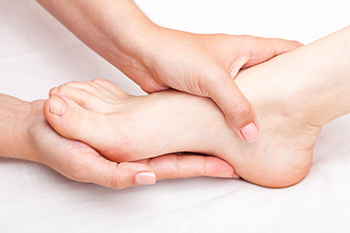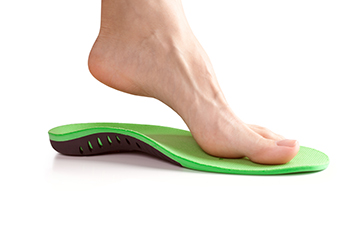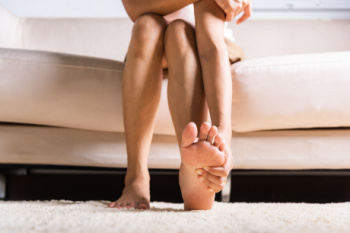Items filtered by date: June 2024
Plantar Fibromas and Nonsurgical Relief Options

A plantar fibroma is a benign, fibrous knot embedded in the plantar fascia, the tissue along the bottom of the foot. This condition often causes a noticeable lump in the arch of the foot, leading to discomfort or pain when walking or standing. Nonsurgical relief options for plantar fibromas focus on reducing symptoms and improving foot function. Orthotic devices such as shoe inserts can help by distributing pressure more evenly across the foot and reducing strain on the plantar fascia. Stretching exercises and massage can alleviate tension and improve flexibility in the foot. Additionally, corticosteroid injections may be administered to reduce inflammation and pain associated with the fibroma. If you have developed a knot in the arch of your foot, it is suggested that you speak with a podiatrist who can determine what the best course of treatment is for you.
A plantar fibroma may disrupt your daily activities. If you have any concerns, contact Shawn Echard, DPM of Laurel Podiatry LLC. Our practitioner can provide the care you need to keep you pain-free and on your feet.
Plantar Fibroma
A plantar fibroma is a fibrous knot in the arch of the foot. It is embedded in the plantar fascia which is a band of tissue that extends from the heel to the toes along the bottom of the foot. There can be multiple plantar fibromas in the feet at the same time. There are no known causes for this condition. If you have a plantar fibroma, there will be a bump in the arch of your foot that cannot be missed. Any associated pain is most often due to a shoe rubbing against the nodule. Non-surgical options, such as steroid injections, physical therapy, and orthotics should be tried first. Surgery is a last resort and is the only thing that will remove a plantar fibroma entirely. Consult with a podiatrist for a proper diagnosis and to determine the treatment regimen that is right for you.
What Causes a Plantar Fibroma?
While there are no specific causes identified, a plantar fibroma can possibly come from genetic predisposition or the formation of scar tissue that forms from healing the tears in the plantar fascia.
What Are the Symptoms of a Plantar Fibroma?
There will be a noticeable lump in the arch of the foot that may or may not cause pain. If pain is felt, it is typically because a shoe is rubbing up against the lump or when walking or standing barefoot.
Treatment and Prevention
A plantar fibroma will not disappear without treatment, but it can get smaller and be a non-issue. If pain persists, a podiatrist examines the foot and when the arch of the foot is pressed, pain can be felt down to the toes. An MRI or biopsy might be performed to help diagnose or evaluate the plantar fibroma. The following non-surgical options are generally enough to reduce the size and pain of these nodules:
- Steroid injections
- Orthotics
- Physical therapy to help apply anti-inflammatory creams on the bump
Surgery is considered if the mass increases in size and the patient continues to feel pain after non-surgical methods are tried.
If you have any questions please feel free to contact our offices located in Greensburg and Somerset, PA . We offer the newest diagnostic tools and technology to treat your foot and ankle needs.
Orthotics Can Help With New Shoes
 Orthotics can significantly alleviate first-step pain often experienced with new shoes by providing customized support and cushioning for the feet. These devices are designed to fit the contours of the foot precisely, reducing stress on the plantar fascia, which is often the source of discomfort. When new shoes lack adequate arch support or cushioning, the plantar fascia can become strained, leading to pain. Orthotics help distribute pressure more evenly across the foot, minimizing the impact on sensitive areas. They also enhance the alignment and function of the foot, promoting a more natural gait and reducing the likelihood of further strain. The materials used in orthotics, such as gel or foam, provide additional shock absorption, making each step less painful. If you are experiencing persistent or severe first-step pain, it is suggested that you consult a podiatrist to discuss whether orthotics can help you and to address any underlying foot conditions.
Orthotics can significantly alleviate first-step pain often experienced with new shoes by providing customized support and cushioning for the feet. These devices are designed to fit the contours of the foot precisely, reducing stress on the plantar fascia, which is often the source of discomfort. When new shoes lack adequate arch support or cushioning, the plantar fascia can become strained, leading to pain. Orthotics help distribute pressure more evenly across the foot, minimizing the impact on sensitive areas. They also enhance the alignment and function of the foot, promoting a more natural gait and reducing the likelihood of further strain. The materials used in orthotics, such as gel or foam, provide additional shock absorption, making each step less painful. If you are experiencing persistent or severe first-step pain, it is suggested that you consult a podiatrist to discuss whether orthotics can help you and to address any underlying foot conditions.
If you are having discomfort in your feet and would like to try orthotics, contact Shawn Echard, DPM from Laurel Podiatry LLC. Our practitioner can provide the care you need to keep you pain-free and on your feet.
What Are Orthotics?
Orthotics are inserts you can place into your shoes to help with a variety of foot problems such as flat feet or foot pain. Orthotics provide relief and comfort for minor foot and heel pain but can’t correct serious biomechanical problems in your feet.
Over-the-Counter Inserts
Orthotics come in a wide variety of over-the-counter inserts that are used to treat foot pain, heel pain, and minor problems. For example, arch supports can be inserted into your shoes to help correct overarched or flat feet, while gel insoles are often used because they provide comfort and relief from foot and heel pain by alleviating pressure.
Prescription Orthotics
If over-the-counter inserts don’t work for you or if you have a more severe foot concern, it is possible to have your podiatrist prescribe custom orthotics. These high-quality inserts are designed to treat problems such as abnormal motion, plantar fasciitis, and severe forms of heel pain. They can even be used to help patients suffering from diabetes by treating foot ulcers and painful calluses and are usually molded to your feet individually, which allows them to provide full support and comfort.
If you are experiencing minor to severe foot or heel pain, it’s recommended to speak with your podiatrist about the possibilities of using orthotics. A podiatrist can determine which type of orthotic is right for you and allow you to take the first steps towards being pain-free.
If you have any questions please contact our offices located in Greensburg and Somerset, PA . We offer the newest diagnostic and treatment technologies for all your foot and ankle needs.
Location of Foot Pain May Indicate the Cause

Foot pain can affect various areas of the foot, each indicating different underlying causes and requiring specific treatment approaches. Pain in the heel, for example, may signal conditions like plantar fasciitis, Achilles tendonitis, or heel spurs, often treated with rest, stretching exercises, or orthotic inserts. Pain in the arch of the foot may result from conditions such as flat feet, plantar fasciitis, or overuse injuries, requiring supportive footwear, arch supports, or custom orthotics for relief. Pain in the ball of the foot could be due to metatarsalgia, Morton's neuroma, or sesamoiditis, necessitating cushioned insoles, proper footwear, or corticosteroid injections. Furthermore, pain in the toes may indicate issues like bunions, hammertoes, or ingrown toenails, often managed with padding, splinting, or surgical intervention. By pinpointing the location of foot pain and understanding its potential causes, a podiatrist can offer appropriate treatment methods to alleviate discomfort and promote foot health. If you have foot pain or discomfort, it is suggested that you make an appointment with a podiatrist for an accurate diagnosis and the appropriate treatment solutions.
Foot Pain
Foot pain can be extremely painful and debilitating. If you have a foot pain, consult with Shawn Echard, DPM from Laurel Podiatry LLC. Our practitioner will assess your condition and provide you with quality foot and ankle treatment.
Causes
Foot pain is a very broad condition that could be caused by one or more ailments. The most common include:
- Bunions
- Hammertoes
- Plantar Fasciitis
- Bone Spurs
- Corns
- Tarsal Tunnel Syndrome
- Ingrown Toenails
- Arthritis (such as Gout, Rheumatoid, and Osteoarthritis)
- Flat Feet
- Injury (from stress fractures, broken toe, foot, ankle, Achilles tendon ruptures, and sprains)
- And more
Diagnosis
To figure out the cause of foot pain, podiatrists utilize several different methods. This can range from simple visual inspections and sensation tests to X-rays and MRI scans. Prior medical history, family medical history, and any recent physical traumatic events will all be taken into consideration for a proper diagnosis.
Treatment
Treatment depends upon the cause of the foot pain. Whether it is resting, staying off the foot, or having surgery; podiatrists have a number of treatment options available for foot pain.
If you have any questions, please feel free to contact our offices located in Greensburg and Somerset, PA . We offer the newest diagnostic and treatment technologies for all your foot care needs.
Plantar Warts Can Be Treated!
Symptoms and Risk Factors of Gout

Gout is a type of arthritis notorious for its sudden and excruciating pain. Gout typically targets one joint at a time, and commonly strikes in the big toe joint. Flares, which are periods of intense symptoms, alternate with remission phases. The primary culprit behind gout is an excess of uric acid in the body, which forms crystals that accumulate in joints, fluids, and tissues, sparking inflammation. While gout has no cure, it can be effectively managed with medication and certain lifestyle adjustments. Diagnosis by a podiatrist usually occurs during a flare up, involving symptom assessment, physical examination, and lab tests to detect uric acid crystals. Seeking diagnosis and treatment from a podiatrist is important due to gout’s nonspecific symptoms that resemble other inflammatory disorders. Treatment typically involves pain management during flare ups with nonsteroidal anti-inflammatory drugs, NSAIDs, or colchicine. Other preventive measures can include dietary changes to eliminate foods rich in purines and weight management to reduce future attacks and complications. If you are experiencing symptoms like sudden joint pain or swelling, especially in the big toe, it is suggested that you schedule an appointment with a podiatrist.
Gout is a painful condition that can be treated. If you are seeking treatment, contact Shawn Echard, DPM from Laurel Podiatry LLC. Our practitioner will treat your foot and ankle needs.
What Is Gout?
Gout is a form of arthritis that is characterized by sudden, severe attacks of pain, redness, and tenderness in the joints. The condition usually affects the joint at the base of the big toe. A gout attack can occur at any random time, such as the middle of the night while you are asleep.
Symptoms
- Intense Joint Pain - Usually around the large joint of your big toe, and it most severe within the first four to twelve hours
- Lingering Discomfort - Joint discomfort may last from a few days to a few weeks
- Inflammation and Redness -Affected joints may become swollen, tender, warm and red
- Limited Range of Motion - May experience a decrease in joint mobility
Risk Factors
- Genetics - If family members have gout, you’re more likely to have it
- Medications - Diuretic medications can raise uric acid levels
- Gender/Age - Gout is more common in men until the age of 60. It is believed that estrogen protects women until that point
- Diet - Eating red meat and shellfish increases your risk
- Alcohol - Having more than two alcoholic drinks per day increases your risk
- Obesity - Obese people are at a higher risk for gout
Prior to visiting your podiatrist to receive treatment for gout, there are a few things you should do beforehand. If you have gout you should write down your symptoms--including when they started and how often you experience them, important medical information you may have, and any questions you may have. Writing down these three things will help your podiatrist in assessing your specific situation so that he or she may provide the best route of treatment for you.
If you have any questions, please feel free to contact our offices located in Greensburg and Somerset, PA . We offer the newest diagnostic and treatment technologies for all your foot care needs.

